Experimental and Finite Element Research on the Failure Mechanism of C/C Composite Joint Structures under Out-of-Plane Loading
Abstract
:1. Introduction
2. Materials and Methods
2.1. Materials and Configuration
2.2. Procedures
3. Results and Discussion
3.1. Failure Mode
3.2. Numerical Simulation
3.3. Progressive Damage
3.4. Finite Element Prediction
4. Conclusions
Author Contributions
Funding
Conflicts of Interest
References
- Buckley, J.D.; Edie, D.D. Carbon-Carbon Materials and Composites; Noyes Publications: New Jersey, NJ, USA, 1993. [Google Scholar]
- Li, T.Q.; Xu, Z.H.; Hu, Z.J.; Yang, X.G. Application of a high thermal conductivity C/C composite in a heat-redistribution thermal protection system. Carbon 2010, 48, 924–925. [Google Scholar] [CrossRef]
- Scarponi, C. Carbon-carbon composites in aerospace engineering. In Advanced Composite Materials for Aerospace Engineering; Woodhead Publishing: Sawston/Cambridge, UK, 2016; pp. 385–412. [Google Scholar]
- Chowdhury, P.; Sehitoglu, H.; Rateick, R. Damage tolerance of carbon-carbon composites in aerospace application. Carbon 2018, 126, 382–393. [Google Scholar] [CrossRef]
- Lachaud, J.; Aspa, Y.; Vignoles, G.L.; Goyheneche, J.M. 3D modeling of thermochemical ablation in carbon-based material: Effect of anisotropy on surface roughness onset. In Proceedings of the 10th ISMSE & the 8th ICPMSE, Collioure, France, 19–23 June 2006; European Space Agency: Paris, France, 2006. [Google Scholar]
- Kumar, S.; Kushwaha, J.; Mondal, S.; Kumar, A.; Jain, R.K.; Devi, G.R. Fabrication and ablation testing of 4D C/C composite at 10 MW/m2 heat flux under a plasma arc heater. Mater. Sci. Eng. A 2013, 566, 102–111. [Google Scholar] [CrossRef]
- Xiao, Y.; Ishikawa, T. Bearing strength and failure behavior of bolted composite joints (Part I: Experimental investigation). Compos. Sci. Technol. 2005, 65, 1022–1031. [Google Scholar] [CrossRef]
- Guo, S.; Morishima, R. Numerical analysis and experiment of composite sandwich T-joints subjected to pulling load. Compos. Struct. 2011, 94, 229–238. [Google Scholar] [CrossRef]
- Stocchi, C.; Robinson, P.; Pinho, S.T. A detailed finite element investigation of composite bolted joints with countersunk fasteners. Compos. Part A 2013, 52, 143–150. [Google Scholar] [CrossRef]
- Gray, P.J.; McCarthy, C.T. A highly efficient user-defined finite element for load distribution analysis of large-scale bolted composite structures. Compos. Sci. Technol. 2011, 71, 1517–1527. [Google Scholar] [CrossRef] [Green Version]
- Olmedo, A.; Santiuste, C. On the prediction of bolted single-lap composite joints. Compos. Struct. 2012, 94, 2110–2117. [Google Scholar] [CrossRef] [Green Version]
- Olmedo, A.; Santiuste, C.; Barbero, E. An analytical model for the secondary bending prediction in single-lap composite bolted-joints. Compos. Struct. 2014, 111, 354–361. [Google Scholar] [CrossRef]
- Sharos, P.A.; Egan, B.; McCarthy, C.T. An analytical model for strength prediction in multi-bolt composite joints at various loading rates. Compos. Struct. 2014, 116, 300–310. [Google Scholar] [CrossRef]
- McCarthy, M.A.; McCarthy, C.T.; Lawlor, V.P.; Stanley, W.F. Three-dimensional finite element analysis of single-bolt, single-lap composite bolted joints: Part I—Model development and validation. Compos. Struct. 2005, 71, 140–158. [Google Scholar] [CrossRef]
- McCarthy, M.A.; Lawlor, V.P.; Stanley, W.F.; McCarthy, C.T. Bolt-hole clearance effects and strength criteria in single-bolt, single-lap, composite bolted joints. Compos. Sci. Technol. 2002, 62, 1415–1431. [Google Scholar] [CrossRef]
- McCarthy, M.A.; McCarthy, C.T.; Padhi, G.S. A simple method for determining the effects of bolt–hole clearance on load distribution in single-column multi-bolt composite joints. Compos. Struct. 2006, 73, 78–87. [Google Scholar] [CrossRef]
- Gray, P.J.; McCarthy, C.T. A global bolted joint model for finite element analysis of load distributions in multi-bolt composite joints. Compos. Part B 2010, 41, 317–325. [Google Scholar] [CrossRef]
- Feo, L.; Marra, G.; Mosallam, A.S. Stress analysis of multi-bolted joints for FRP pultruded composite structures. Compos. Struct. 2012, 94, 3769–3780. [Google Scholar] [CrossRef]
- Karakuzu, R.; Taylak, N.; Icten, B.M.; Aktas, M. Effects of geometric parameters on failure behavior in laminated composite plates with two parallel pin-loaded holes. Compos. Struct. 2008, 85, 1–9. [Google Scholar] [CrossRef]
- Atas, A.; Mohamed, G.F.; Soutis, C. Effect of clamping force on the delamination onset and growth in bolted composite laminates. Compos. Struct. 2012, 94, 548–552. [Google Scholar] [CrossRef]
- Khashaba, U.A.; Sebaey, T.A.; Alnefaie, K.A. Failure and reliability analysis of pinned-joints composite laminates: Effects of stacking sequences. Compos. Part B 2013, 45, 1694–1703. [Google Scholar] [CrossRef]
- Wang, H.Q.; Cao, J.; Feng, J.C. Brazing mechanism and infiltration strengthening of CC composites to TiAl alloys joint. Scripta Mater. 2010, 63, 859–862. [Google Scholar] [CrossRef]
- Sharma, R.; Mahajan, P.; Mittal, R.K. Elastic modulus of 3D carbon/carbon composite using image-based finite element simulations and experiments. Compos. Struct. 2013, 98, 69–78. [Google Scholar] [CrossRef]
- Cheng, J.; Li, H.J.; Zhang, S.Y.; Xue, L.Z.; Luo, W.F.; Li, W. Failure behavior investigation of a unidirectional carbon–carbon composite. Mater. Des. 2014, 55, 846–850. [Google Scholar] [CrossRef]
- Bruneton, E.; Narcy, B.; Oberlin, A. Carbon-carbon composites prepared by a rapid densification process I: Synthesis and physico-chemical data. Carbon 1997, 35, 1593–1598. [Google Scholar] [CrossRef]
- Westwood, M.E.; Webster, J.D.; Day, R.J.; Hayes, F.H.; Taylor, R. Oxidation protection for carbon fibre composites. J. Mater. Sci. 1996, 31, 1389–1397. [Google Scholar] [CrossRef]
- Golecki, I.; Morris, R.C.; Narasimhan, D.; Clements, N. Rapid densification of porous carbon–carbon composites by thermal-gradient chemical vapor infiltration. Appl. Phys. Lett. 1995, 66, 2334–2336. [Google Scholar] [CrossRef]
- Delhaès, P.; Trinquecoste, M.; Lines, J.F.; Cosculluela, A.; Goyheneche, J.M.; Couzi, M. Chemical vapor infiltration of C/C composites: Fast densification processes and matrix characterizations. Carbon 2005, 43, 681–691. [Google Scholar] [CrossRef]
- Fang, H.T.; Zhu, J.C.; Yin, Z.D.; Jeon, J.H.; Hahn, Y.D. A Si-Mo fused slurry coating for oxidation protection of carbon-carbon composites. J. Mater. Sci. Lett. 2001, 20, 175–177. [Google Scholar] [CrossRef]
- Delhaes, P. Chemical vapor deposition and infiltration processes of carbon materials. Carbon 2002, 40, 641–657. [Google Scholar] [CrossRef]
- Hashin, Z. Failure Criteria for Unidirectional Fiber Composites. J. Appl. Mech. 1980, 47, 329–334. [Google Scholar] [CrossRef]
- Tang, Y.L.; Zhou, Z.G.; Pan, S.D.; Xiong, J.; Guo, Y. Mechanical property and failure mechanism of 3D Carbon–Carbon braided composites bolted joints under unidirectional tensile loading. Mater. Des. 2015, 65, 243–253. [Google Scholar] [CrossRef]
- Coelho, A.M.G.; Mottram, J.T. Numerical Evaluation of Pin-Bearing Strength for the Design of Bolted Connections of Pultruded FRP Material. J. Compos. Constr. 2017, 21, 04017027. [Google Scholar] [CrossRef] [Green Version]
- Harper, P.W.; Hallett, S.R. Cohesive zone length in numerical simulations of composite delamination. Eng. Fract. Mech. 2008, 75, 4774–4792. [Google Scholar] [CrossRef] [Green Version]


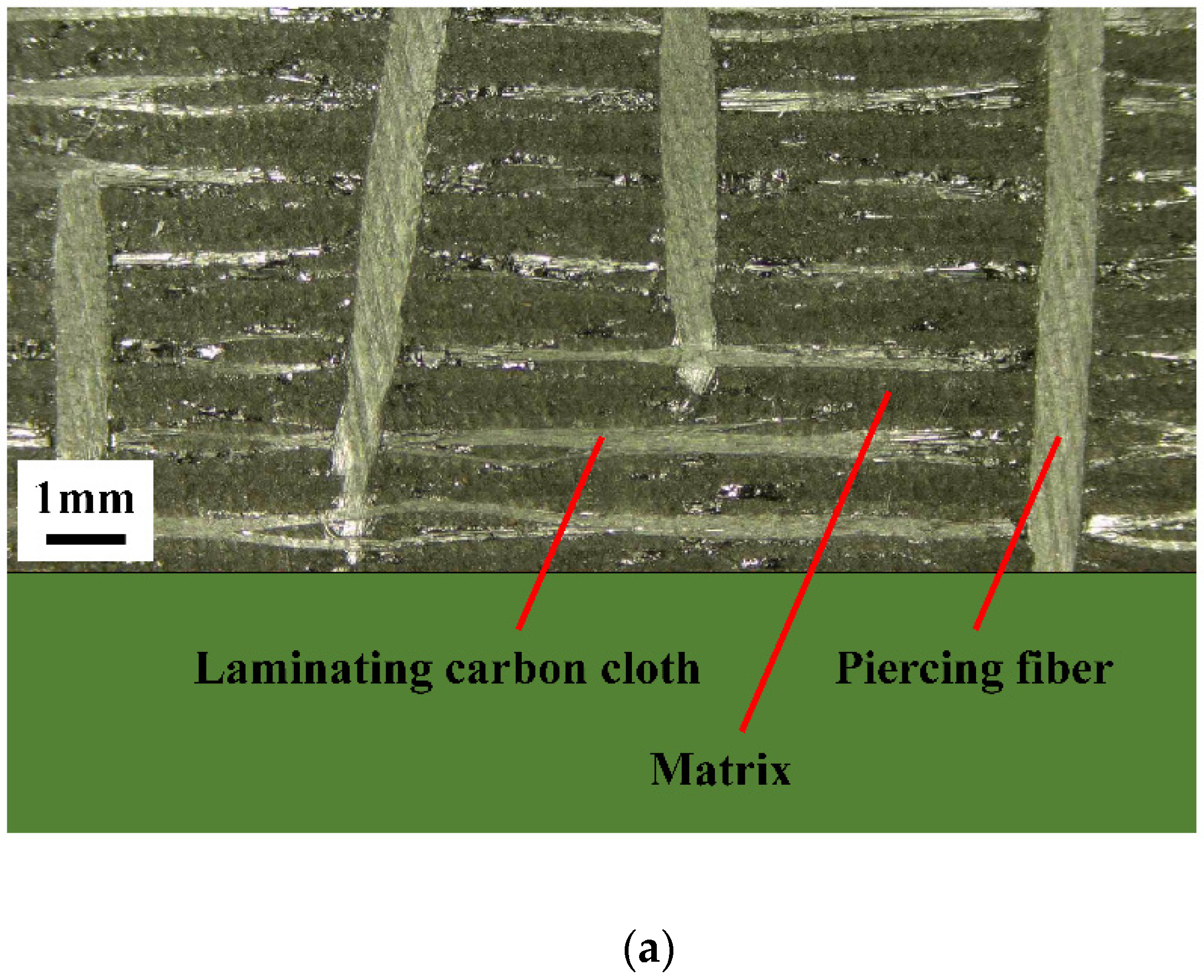
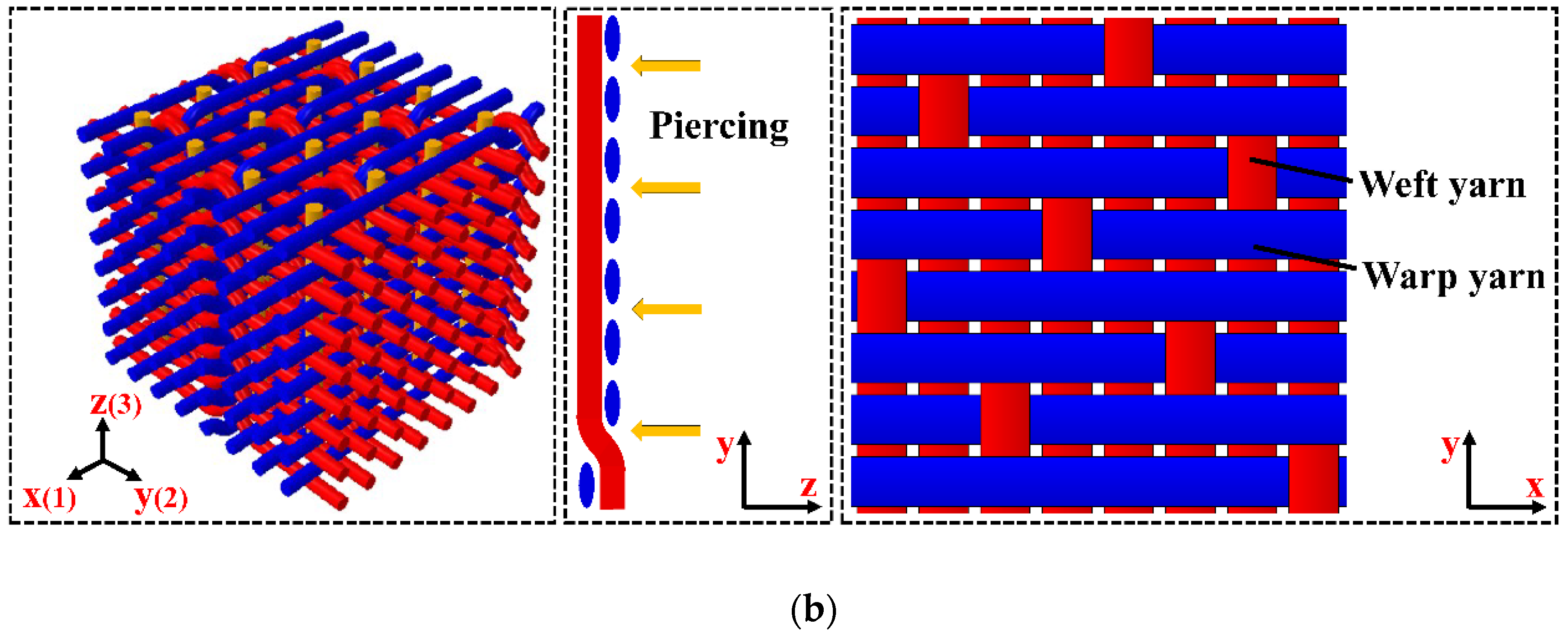
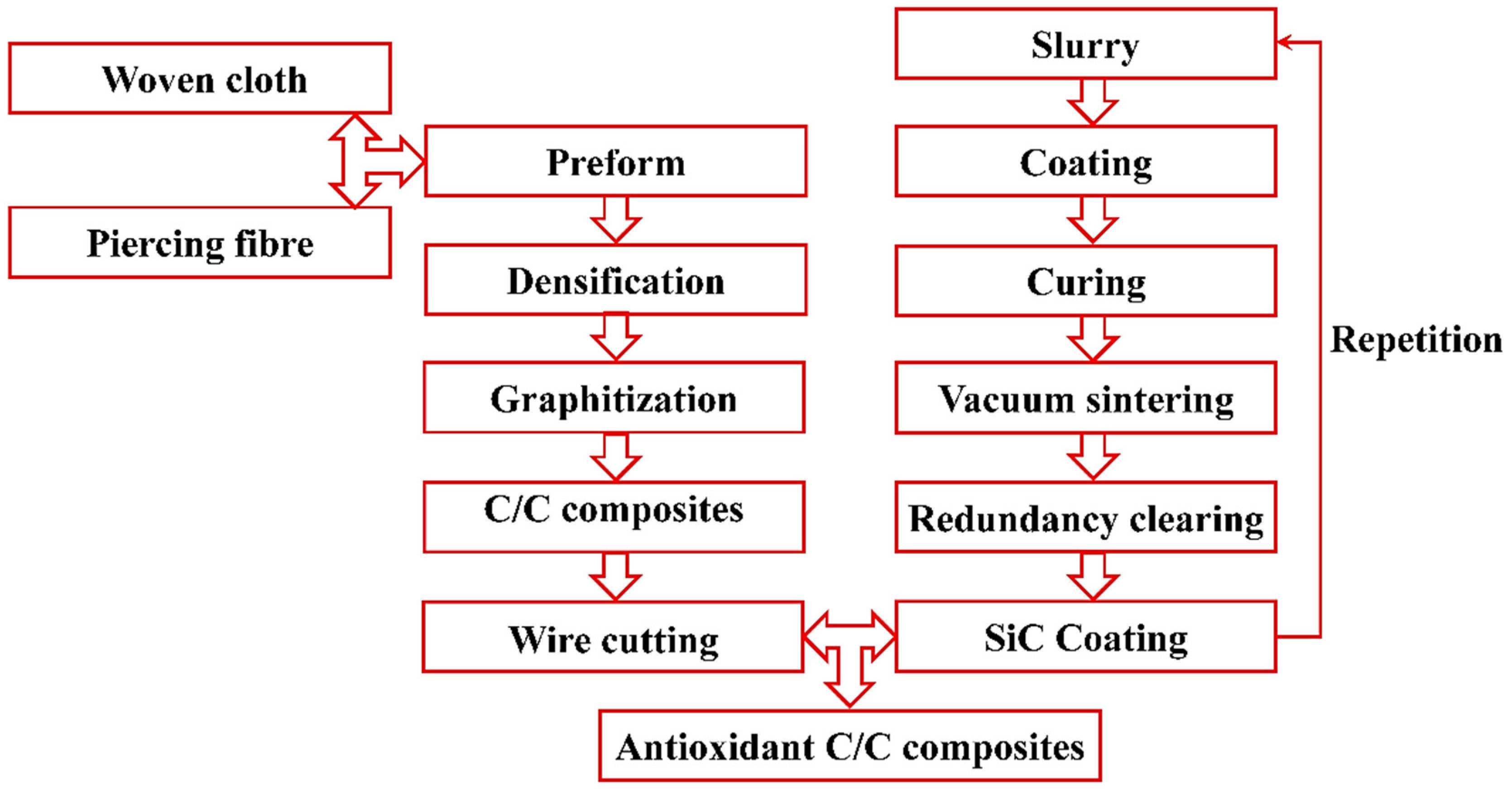
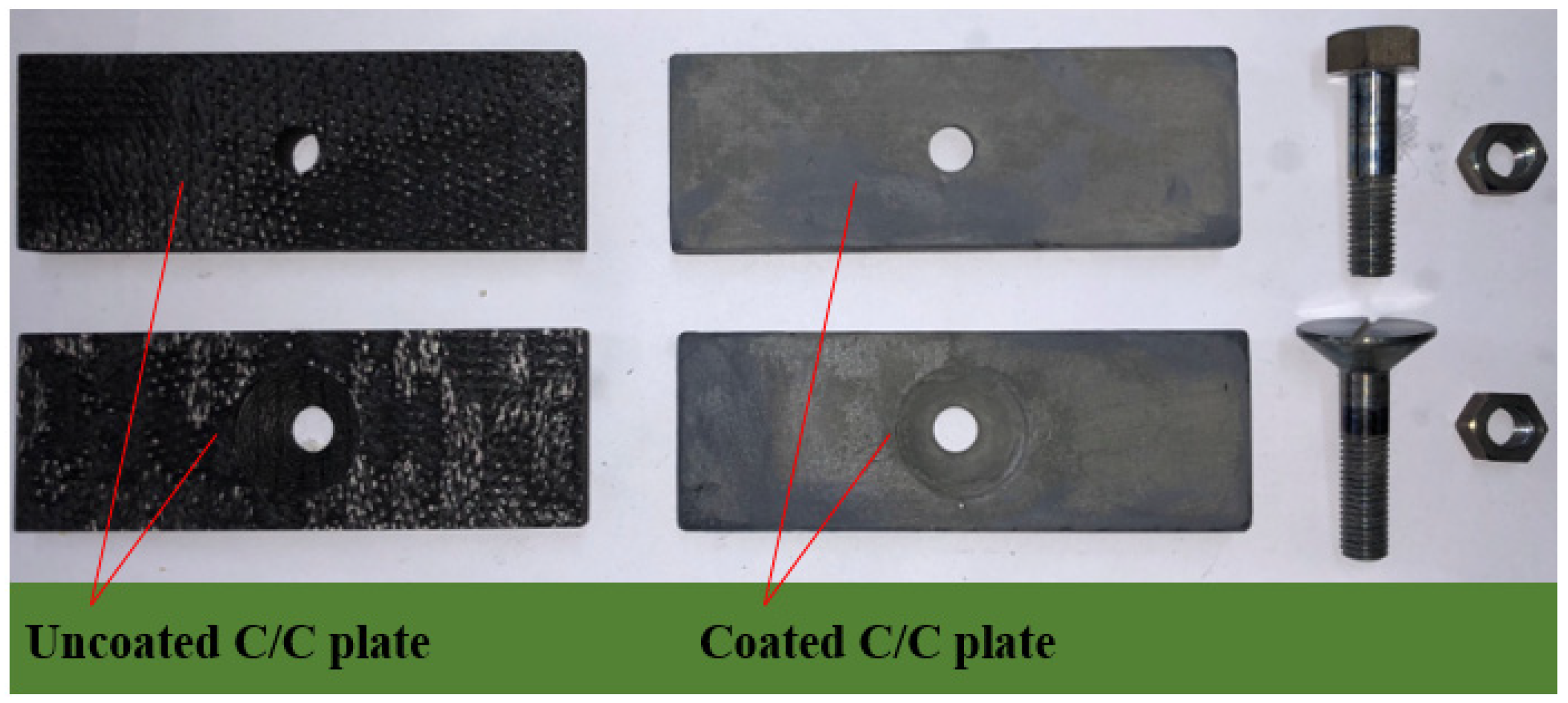
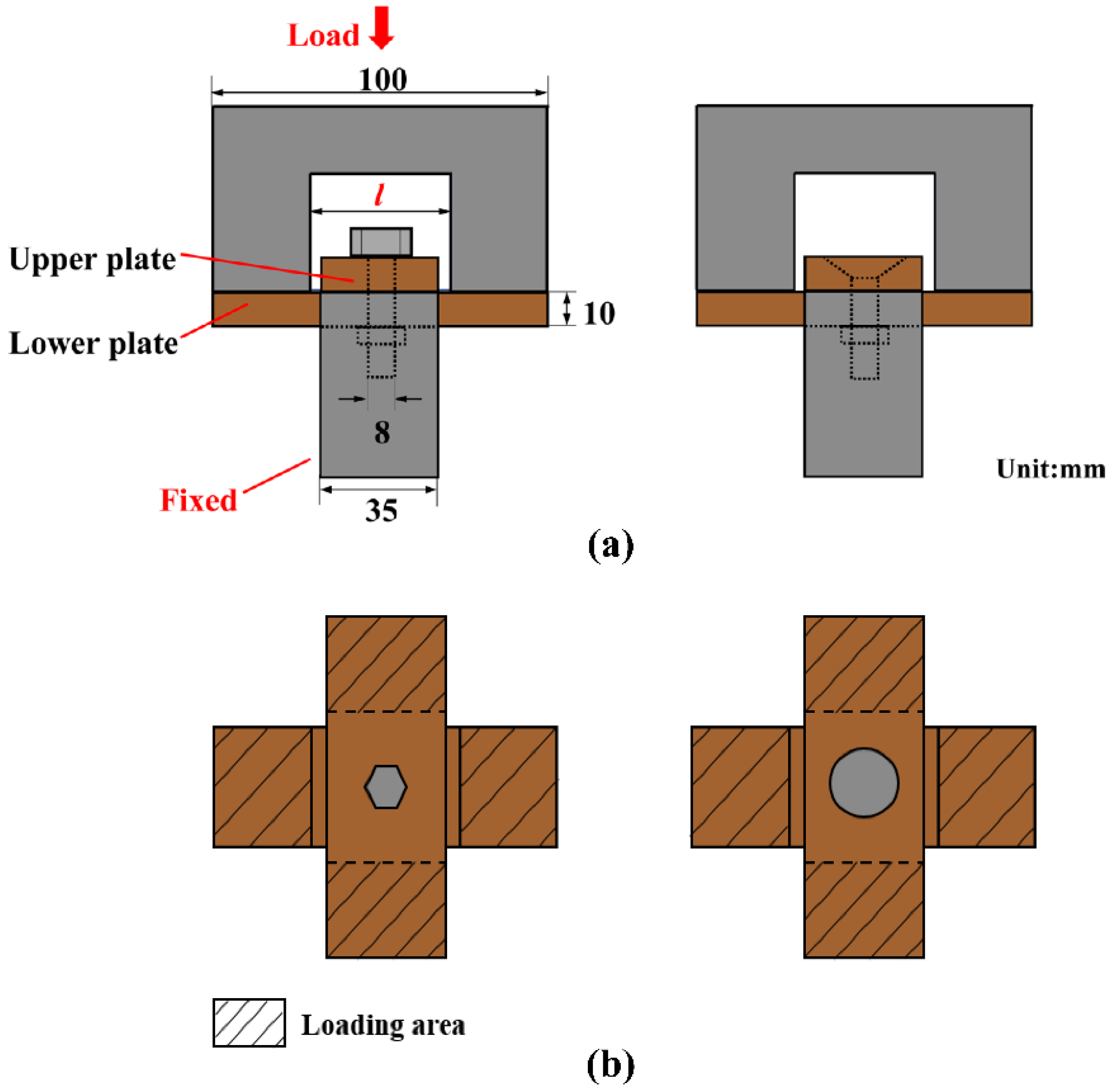
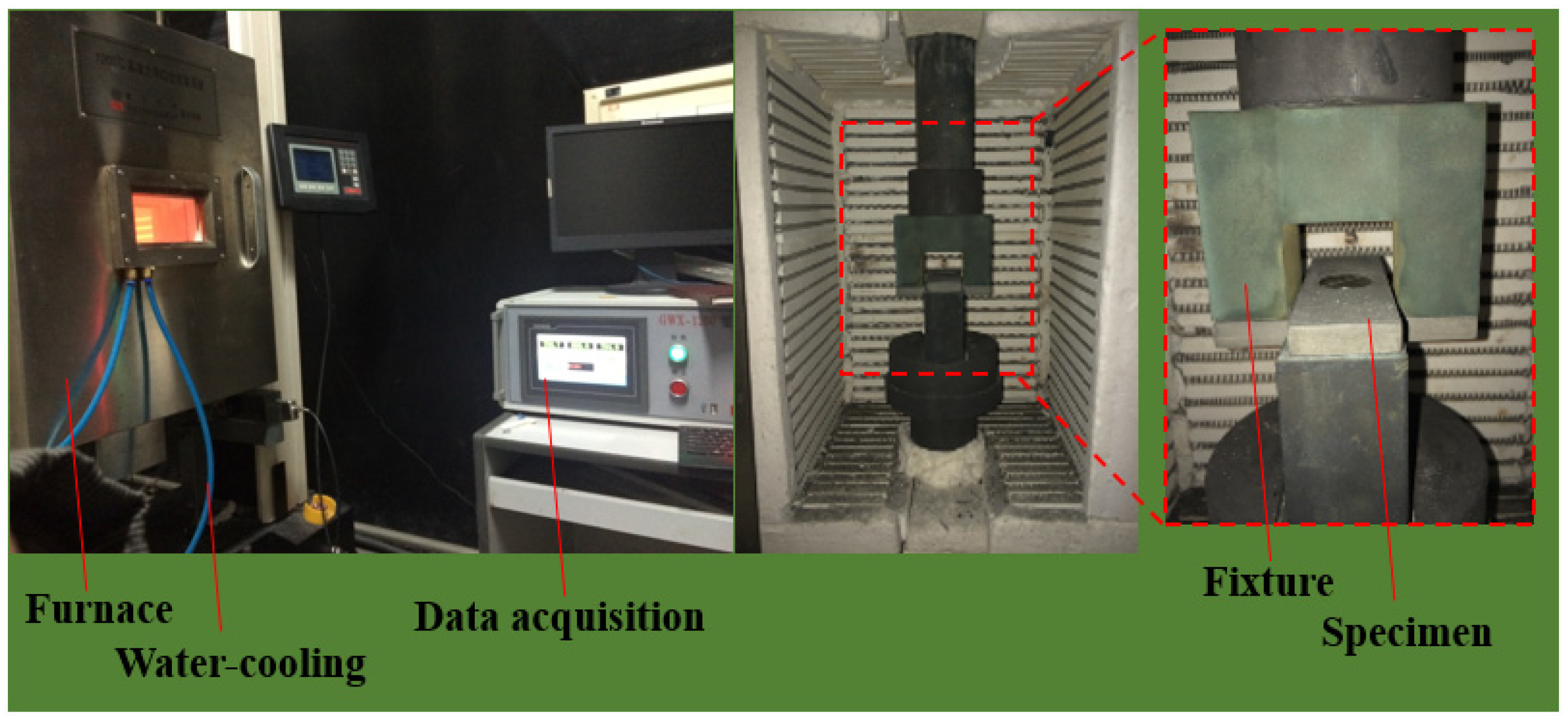
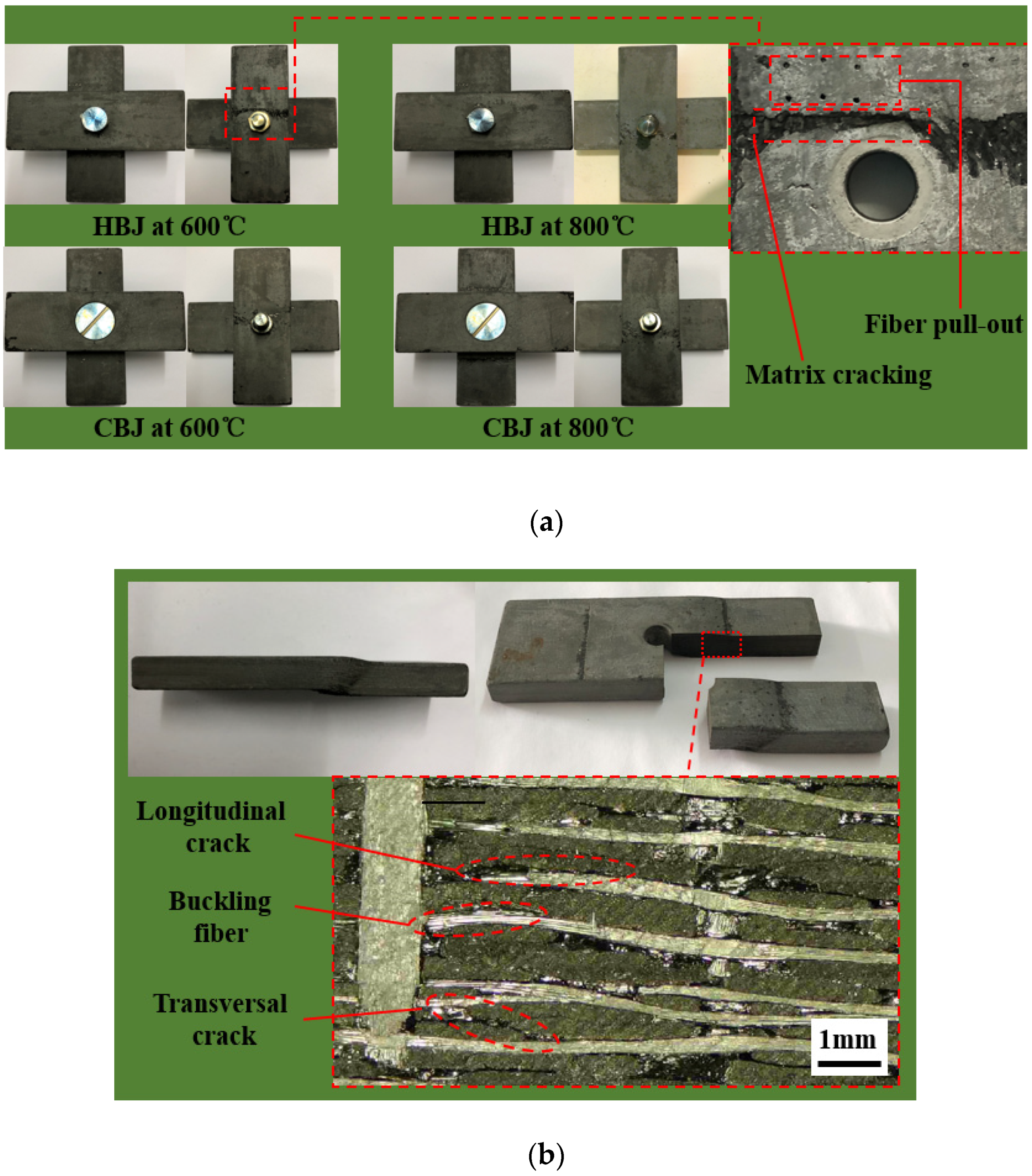



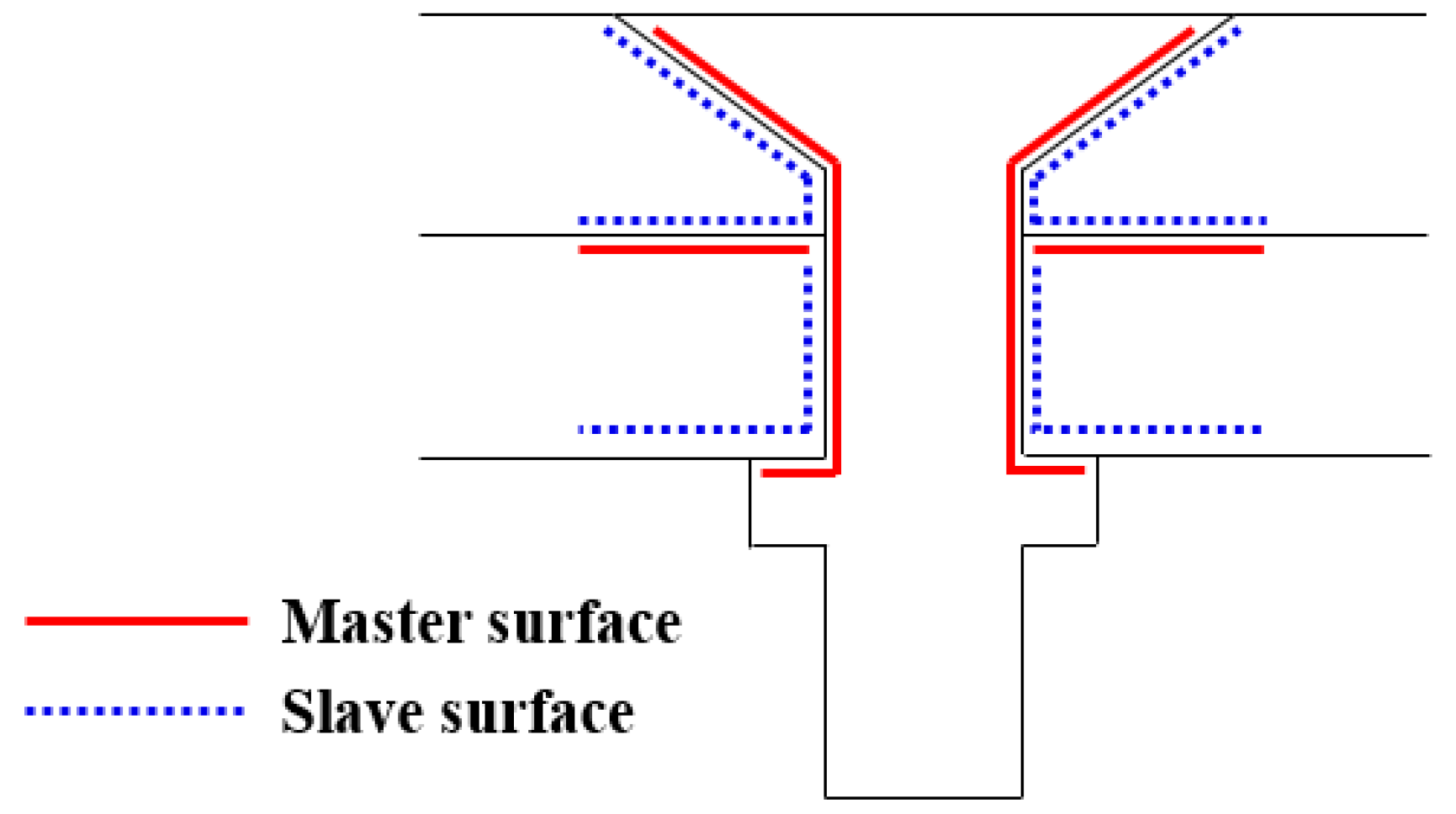


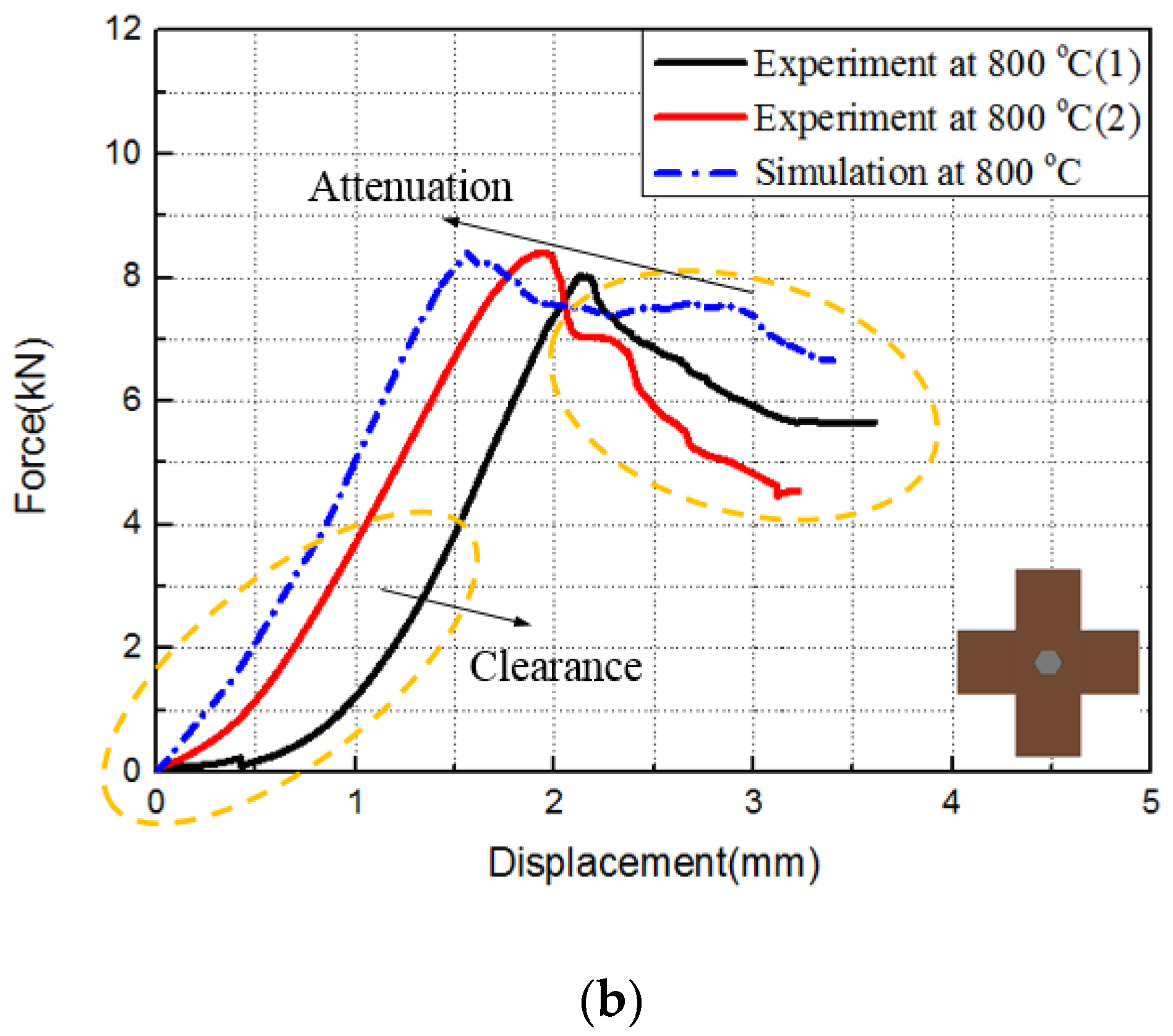
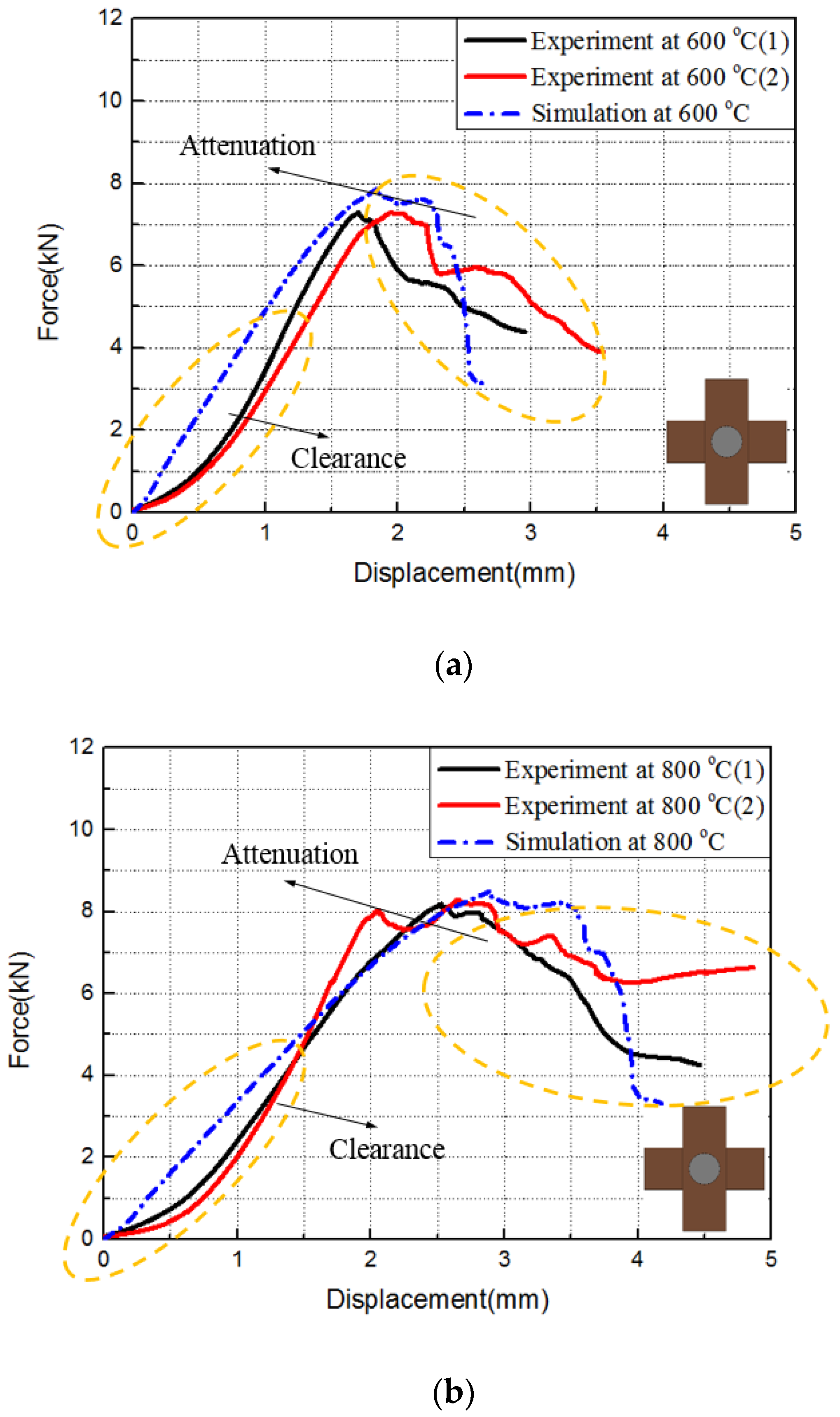


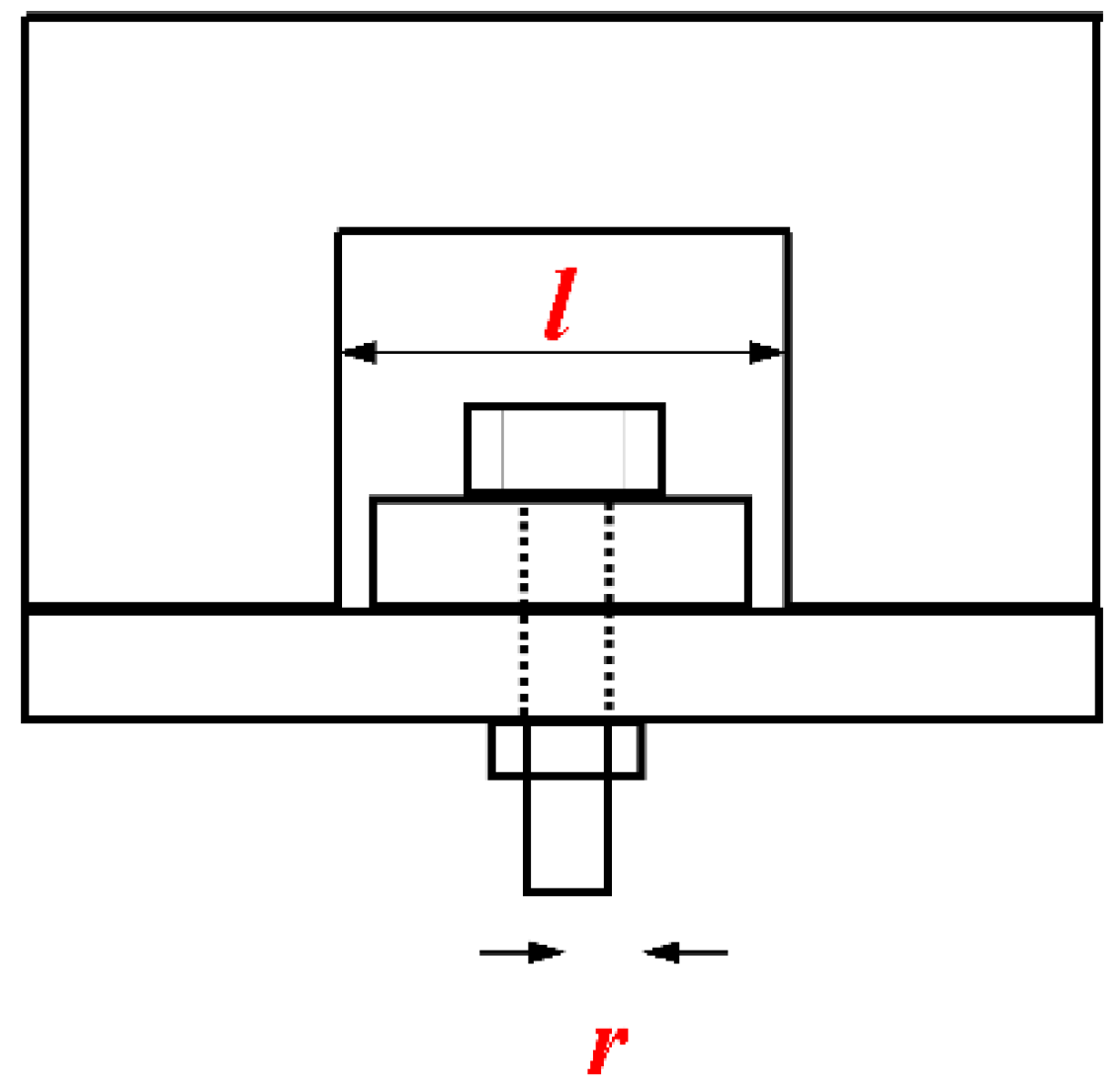

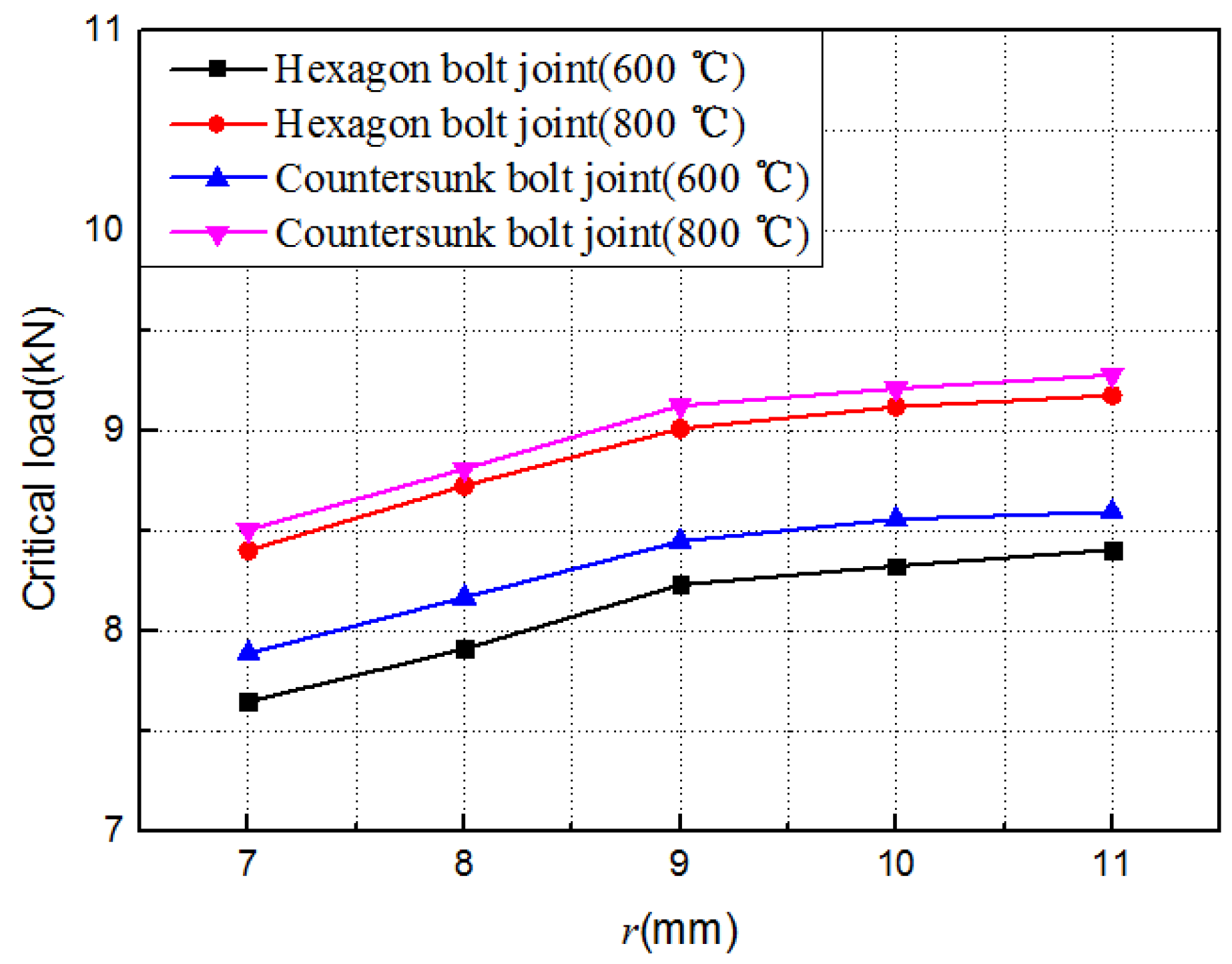
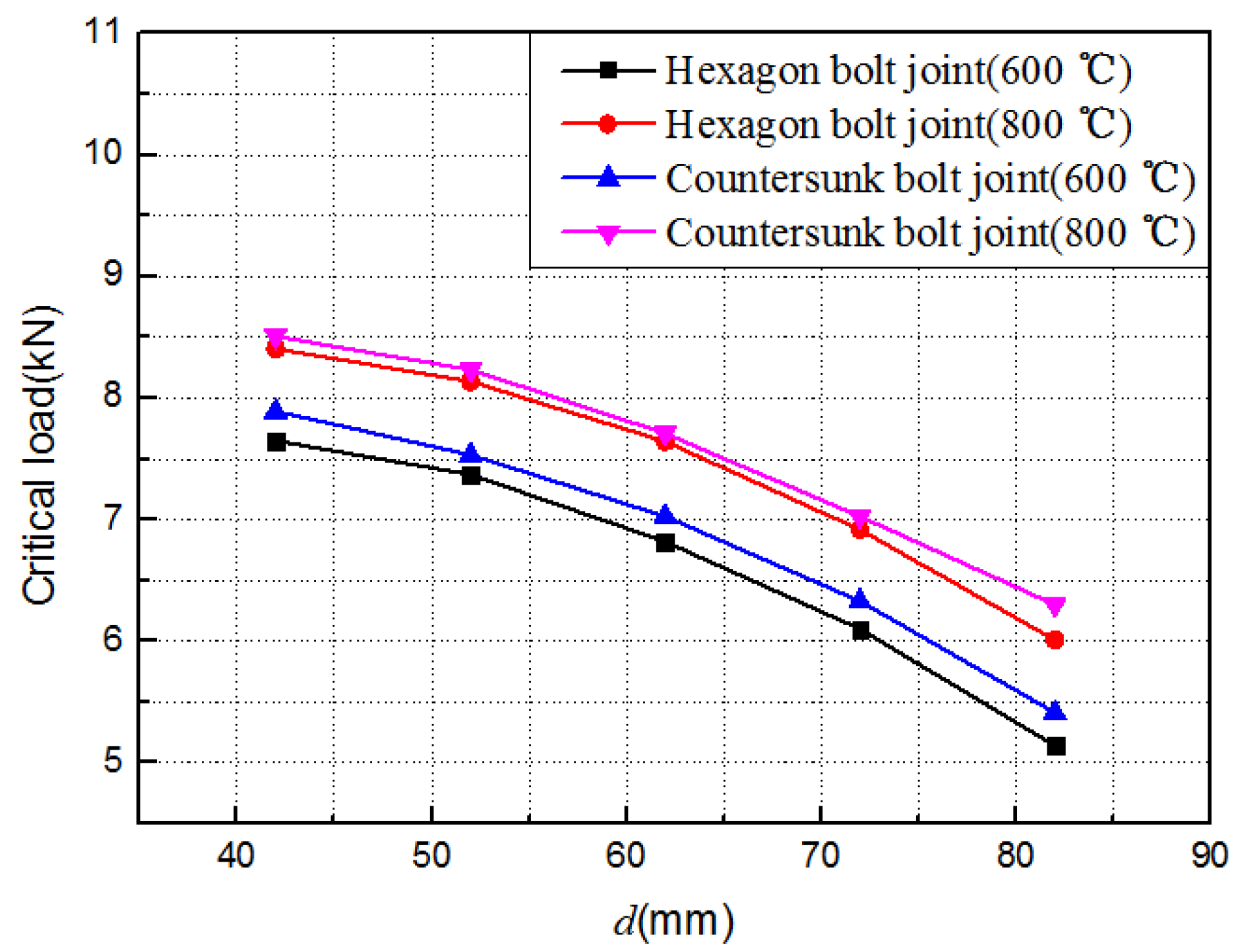
| RT | 600 °C | 800 °C | RT | 600 °C | 800 °C | ||
|---|---|---|---|---|---|---|---|
| Density (g/cm3) | 1.65 | Tensile strength (MPa) | 260 | 263 | 271.3 | ||
| Coefficient of thermal expansion (10–6/°C) | 0.19 | Compression strength (MPa) | 176 | 212 | 224 | ||
| Elastic modulus (GPa) | 85 | 92.5 | 95 | Tensile strength (MPa) | 260 | 263 | 271.3 |
| Elastic modulus (GPa) | 85 | 92.5 | 95 | Compression strength (MPa) | 176 | 212 | 224 |
| Elastic modulus (GPa) | 21 | 13 | 10.3 | Tensile strength (MPa) | 78.6 | 80.2 | 84.9 |
| Shear modulus (GPa) | 20 | 25.7 | 27.6 | Compression strength (MPa) | 326 | 350 | 358 |
| Shear modulus (GPa) | 4 | 6.1 | 6.8 | Shear strength (MPa) | 43 | 51 | 54.5 |
| Poisson ratio | 0.035 | Shear strength (MPa) | 11 | 16.4 | 18.2 | ||
| Poisson ratio = | 0.032 | ||||||
| Temperature | (mJ/mm2) | |||
|---|---|---|---|---|
| RT | 20.2 | 13 | 13 | 0.3 |
| 600 °C | 21.3 | 13.8 | 13.8 | 0.32 |
| 800 °C | 21.7 | 14 | 14 | 0.33 |
| Hexagon Bolt Joint (N) | Countersunk Bolt Joint (N) | ||||
|---|---|---|---|---|---|
| 600 °C | 800 °C | 600 °C | 800 °C | ||
| Experiment | 1 | 7155 | 8028 | 7294 | 8186 |
| 2 | 7134 | 8396 | 7302 | 8296 | |
| Simulation | 7648 | 8405 | 7890 | 8508 | |
© 2019 by the authors. Licensee MDPI, Basel, Switzerland. This article is an open access article distributed under the terms and conditions of the Creative Commons Attribution (CC BY) license (http://creativecommons.org/licenses/by/4.0/).
Share and Cite
Zhang, Y.; Zhou, Z.; Tan, Z. Experimental and Finite Element Research on the Failure Mechanism of C/C Composite Joint Structures under Out-of-Plane Loading. Materials 2019, 12, 2922. https://doi.org/10.3390/ma12182922
Zhang Y, Zhou Z, Tan Z. Experimental and Finite Element Research on the Failure Mechanism of C/C Composite Joint Structures under Out-of-Plane Loading. Materials. 2019; 12(18):2922. https://doi.org/10.3390/ma12182922
Chicago/Turabian StyleZhang, Yanfeng, Zhengong Zhou, and Zhiyong Tan. 2019. "Experimental and Finite Element Research on the Failure Mechanism of C/C Composite Joint Structures under Out-of-Plane Loading" Materials 12, no. 18: 2922. https://doi.org/10.3390/ma12182922




